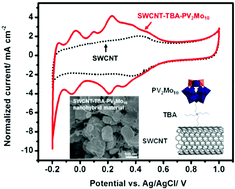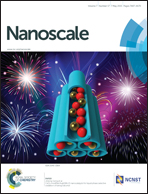A novel SWCNT-polyoxometalate nanohybrid material as an electrode for electrochemical supercapacitors
Abstract
A novel nanohybrid material that combines single-walled carbon nanotubes (SWCNTs) with a polyoxometalate (TBA)5[PVV2MoVI10O40] (TBA-PV2Mo10, TBA: [(CH3(CH2)3)4N]+, tetra-n-butyl ammonium) is investigated for the first time as an electrode material for supercapacitors (SCs) in this study. The SWCNT-TBA-PV2Mo10 material has been prepared by a simple solution method which electrostatically attaches anionic [PV2Mo10O40]5− anions with organic TBA cations on the SWCNTs. The electrochemical performance of SWCNT-TBA-PV2Mo10 electrodes is studied in an acidic aqueous electrolyte (1 M H2SO4) by galvanostatic charge/discharge and cyclic voltammetry. In this SWCNT-TBA-PV2Mo10 nanohybrid material, TBA-PV2Mo10 provides redox activity while benefiting from the high electrical conductivity and high double-layer capacitance of the SWCNTs that improve both energy and power density. An assembled SWCNT-TBA-PV2Mo10 symmetric SC exhibits a 39% higher specific capacitance as compared to a symmetric SC employing only SWCNTs as electrode materials. Furthermore, the SWCNT-TBA-PV2Mo10 SC exhibits excellent cycling stability, retaining 95% of its specific capacitance after 6500 cycles.


 Please wait while we load your content...
Please wait while we load your content...